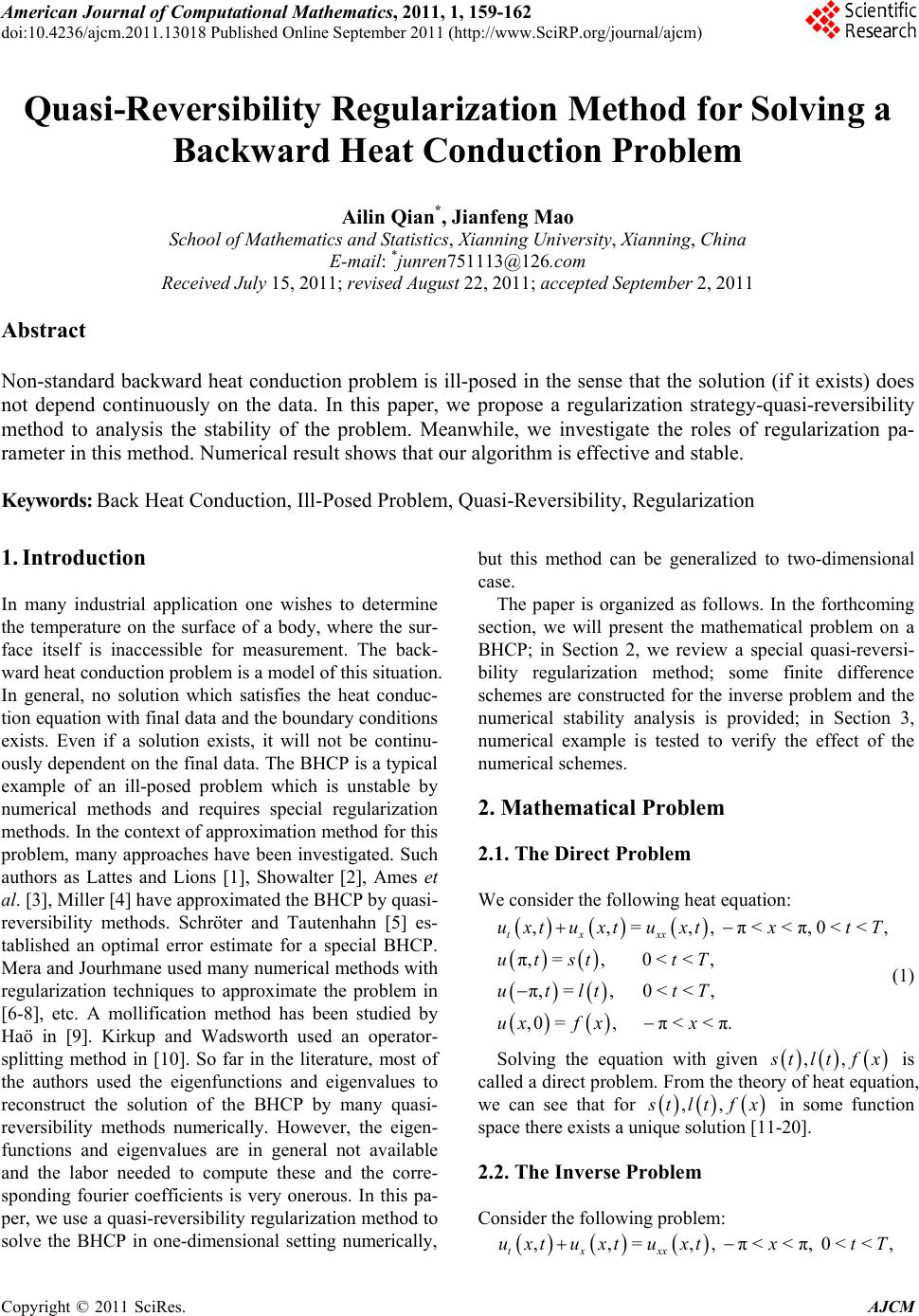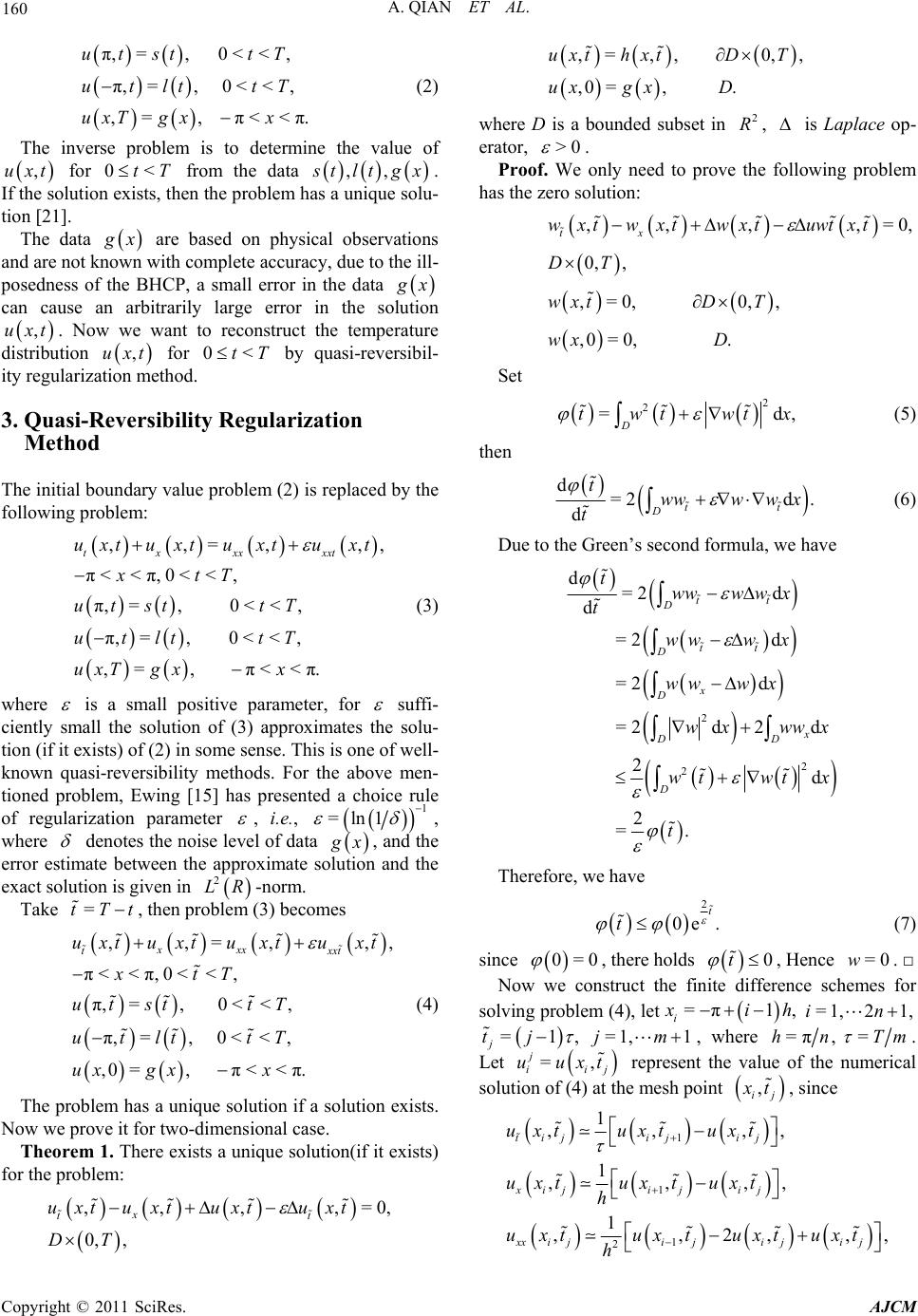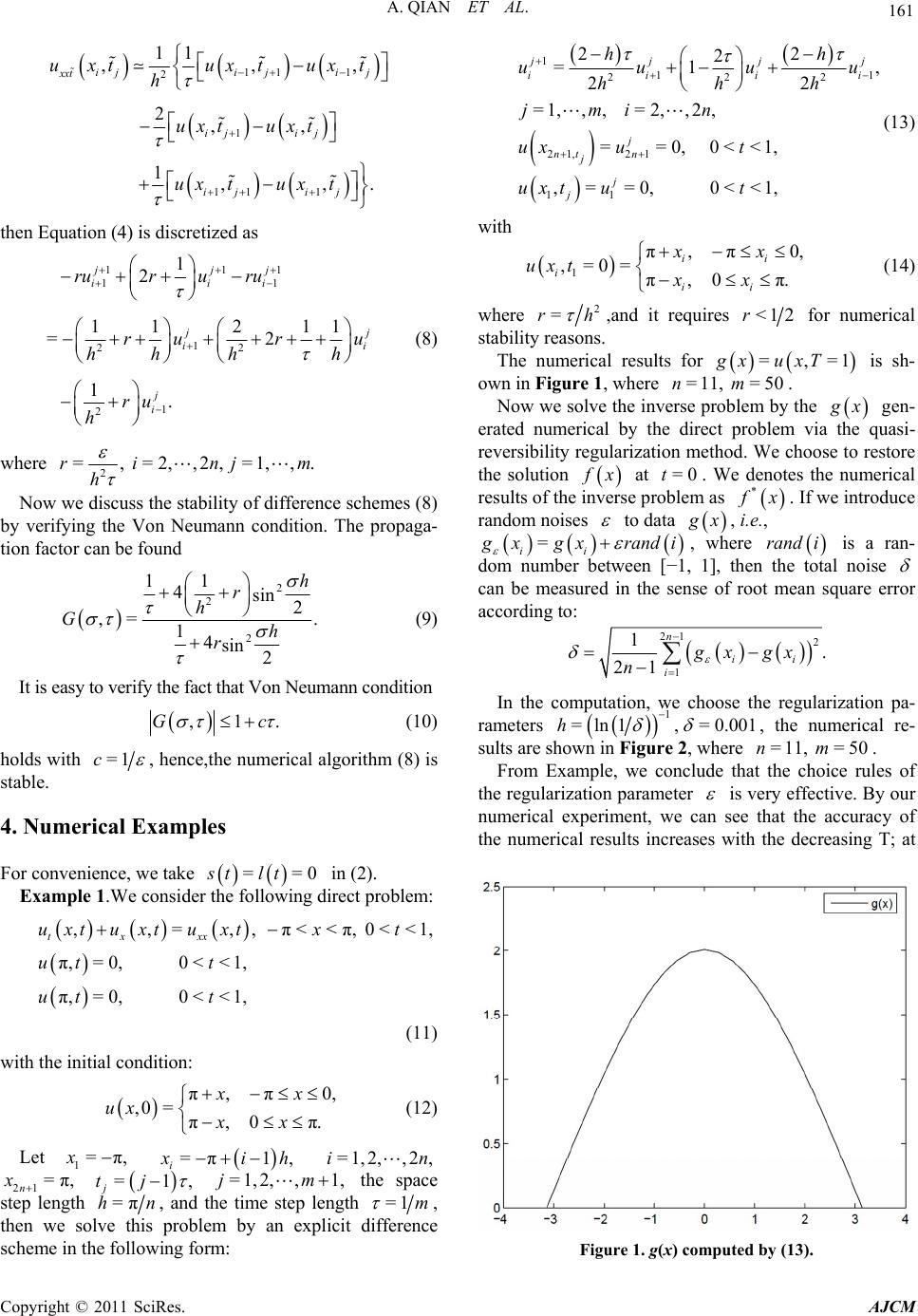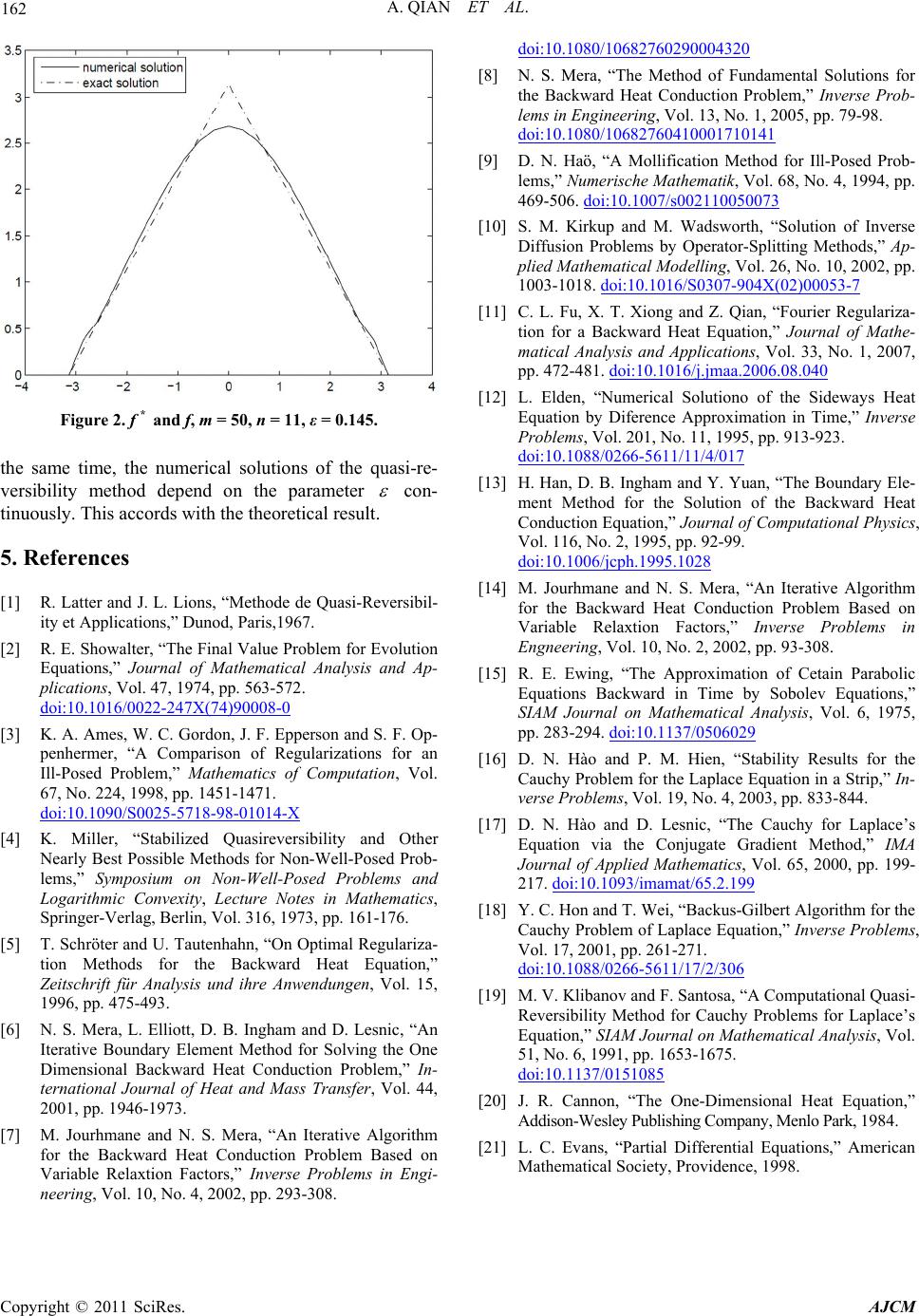 American Journal of Computational Mathematics, 2011, 1, 159-162 doi:10.4236/ajcm.2011.13018 Published Online September 2011 (http://www.SciRP.org/journal/ajcm) Copyright © 2011 SciRes. AJCM Quasi-Reversibility Regularization Method for Solving a Backward Heat Conduction Problem Ailin Qian*, Jianfeng Mao School of Mathematics and Statistics, Xianning University, Xianning, China E-mail: *junren751113@126.com Received July 15, 2011; revised August 22, 2011; accepted September 2, 2011 Abstract Non-standard backward heat conduction problem is ill-posed in the sense that the solution (if it exists) does not depend continuously on the data. In this paper, we propose a regularization strategy-quasi-reversibility method to analysis the stability of the problem. Meanwhile, we investigate the roles of regularization pa- rameter in this method. Numerical result shows that our algorithm is effective and stable. Keywords: Back Heat Conduction, Ill-Posed Problem, Quasi-Reversibility, Regularization 1. Introduction In many industrial application one wishes to determine the temperature on the surface of a body, where the sur- face itself is inaccessible for measurement. The back- ward heat conduction problem is a model of this situation. In general, no solution which satisfies the heat conduc- tion equation with final data and the boundary conditions exists. Even if a solution exists, it will not be continu- ously dependent on the final data. The BHCP is a typical example of an ill-posed problem which is unstable by numerical methods and requires special regularization methods. In the context of approximation method for this problem, many approaches have been investigated. Such authors as Lattes and Lions [1], Showalter [2], Ames et al. [3], Miller [4] have approximated the BHCP by quasi- reversibility methods. Schröter and Tautenhahn [5] es- tablished an optimal error estimate for a special BHCP. Mera and Jourhmane used many numerical methods with regularization techniques to approximate the problem in [6-8], etc. A mollification method has been studied by Haö in [9]. Kirkup and Wadsworth used an operator- splitting method in [10]. So far in the literature, most of the authors used the eigenfunctions and eigenvalues to reconstruct the solution of the BHCP by many quasi- reversibility methods numerically. However, the eigen- functions and eigenvalues are in general not available and the labor needed to compute these and the corre- sponding fourier coefficients is very onerous. In this pa- per, we use a quasi-reversibility regularization method to solve the BHCP in one-dimensional setting numerically, but this method can be generalized to two-dimensional case. The paper is organized as follows. In the forthcoming section, we will present the mathematical problem on a BHCP; in Section 2, we review a special quasi-reversi- bility regularization method; some finite difference schemes are constructed for the inverse problem and the numerical stability analysis is provided; in Section 3, numerical example is tested to verify the effect of the numerical schemes. 2. Mathematical Problem 2.1. The Direct Problem We consider the following heat equation: ,,=,,π<<π,0< <, π,=, 0<<, π,=, 0<<, ,0=, π<<π. tx xx uxtuxtuxtxt T utst tT utlt tT uxf xx (1) Solving the equation with given ,, tlt fx is called a direct problem. From the theory of heat equation, we can see that for ,, tlt fx in some function space there exists a unique solution [11-20]. 2.2. The Inverse Problem Consider the following problem: ,,=,,π<<π, 0<<, tx xx uxtuxtuxtxt T  160 A. QIAN ET AL. π,=, 0<<, π,=, 0<<, ,=, π<<π. utst tT utlt tT uxT gxx (2) The inverse problem is to determine the value of for from the data ,uxt 0<tT ,, tltgx. If the solution exists, then the problem has a unique solu- tion [21]. The data x are based on physical observations and are not known with complete accuracy, due to the ill- posedness of the BHCP, a small error in the data x can cause an arbitrarily large error in the solution . Now we want to reconstruct the temperature distribution for by quasi-reversibil- ity regularization method. ,uxt ,uxt 0<tT 3. Quasi-Reversibility Regularization Method The initial boundary value problem (2) is replaced by the following problem: ,,=, , π<<π,0< <, π,=, 0<<, π,=, 0<<, ,=, π<<π. t xxxxxt u xtuxtuxtuxt xtT utst tT utlt tT uxT gxx , (3) where is a small positive parameter, for suffi- ciently small the solution of (3) approximates the solu- tion (if it exists) of (2) in some sense. This is one of well- known quasi-reversibility methods. For the above men- tioned problem, Ewing [15] has presented a choice rule of regularization parameter , i.e. , 1 =ln1 , where denotes the noise level of data x, and the error estimate between the approximate solution and the exact solution is given in 2 LR-norm. Take , then problem (3) becomes =tTt ,,=, , π<<π,0<<, π,=, 0<<, π,=, 0<<, ,0=, π<<π. xxx t xxt uxtuxtu xtuxt xtT ut sttT utlt tT ux gxx , =0, (4) The problem has a unique solution if a solution exists. Now we prove it for two-dimensional case. Theorem 1. There exists a unique solution(if it exists) for the problem: ,, ,, 0, , x tt uxtuxtu xtuxt DT ,=,, 0,, ,0=, . uxthxtDT ux gxD where D is a bounded subset in , is Laplace op- erator, 2 R >0 . Proof. We only need to prove the following problem has the zero solution: ,, ,, 0, , ,=0,0,, ,0= 0,. x t wxtwxtwxtuwtxt DT wxtD T wx D =0, Set 2 2 =d D twtwt ,x (5) then d=2d . dtt D twwww x t (6) Due to the Green’s second formula, we have 2 2 2 d=2 d d = 2d = 2d =2d2d 2 d 2 =. tt D tt D x D x DD D twww wx t wwwx www x wx wwx wtwt x t Therefore, we have 2 0e . t t (7) since 0=0 , there holds , Hence . □ 0t =0w Now we construct the finite difference schemes for solving problem (4), let =π1, i ih =1, 21,in =1 j tj, =1,j1m , where =π,=hn Tm . Let , i j xt = j i uu represent the value of the numerical solution of (4) at the mesh point , ij t , since 1 1 1 2 1 ,,,, 1 ,,,, 1 ,,2, ijij ij t xiji jij xx ijijijij uxtuxt uxt uxtux tuxt h uxtuxtuxt uxt h ,, Copyright © 2011 SciRes. AJCM  A. QIAN ET AL. 161 11 1 2 1 11 1 11 ,, 2 ,, 1 ,,. ijij ij xxt ij ij ij ij uxtuxt uxt h uxt uxt ux tuxt , then Equation (4) is discretized as 111 11 1 22 1 2 1 2 112 11 =2 1 . jjj iii j ii i ruru ru rur u hh hh h (8) where j ru 2 =, =2,,2, =1,,.ri nj h m Now we discuss the stability of difference sch by verifying the Von Neumann condition. The propaga- tion factor can be found emes (8) 2 2 2 11 4sin 2 ,= . 14sin 2 r h r h Gh (9) It is easy to verify the fact that Von Neumann condition ,1Gc. (10) holds with =1c , hence,the numerical algorithm stable. 4. Numerical Examples For convenience, we take Example 1.We considerect problem: (11) w (12) Let (8) is =stlt r the following di =0 in (2). ,,=,, π<<π, 0<<1, t uxt π,= 0, 0<<1, , x xx uxtu xtxt ut t π,= 0, 0<<1ut t ith the initial condition: π,π0, ,0 =π,0 π. xx ux xx 1=π,x =π1, i ih =1, =1,2,,2 ,in 21 = n xπ, j tj =1,2, ,1, the spjm ace step length =πhn, and the time step length =1 m , then we solve this problem by an ex plicit differe scheme in the following form: nce 21 , 1 11 0, 0<<1, ,==0, 0<<1, 1 11 22 2 22 2 =1 22 =1, ,,=2, ,2, == 2 , jj iii j t j hh uuu hhh m n u j i u nn j j ji ux t uxt ut ) (13 with 1 π,π0, ,=0= π,0π. ii iii xx uxt xx (14) where 2 =rh ,and it requires <1 2r for nume stability reasons. The numerical results for is sh- own in Figure 1, where w we solve the inverse problem by the rical =,=1gx uxT 11, =50nm . = No x a the quasi- gen- numerical by the direct problem vi reversibility regularization method. We ch the solution erated oose to restore x e inv at We denotes therical h =0t. e num results of terse problem as * x. If we introduce random noises to data x, i.e., = ii xgxrandi , wa ran- dom number between [−e ise h ], t ere rand hen th is tal no i to1, 1 can be measured in the sense of root mean s according to: quare error 21 2 1 1. n ii i gx gx n In the computation, we cse the regularization pa- ram 21 hoo eters 1 =ln1,=0.001 , merical re- sults are shown in Figure 2, where =11, = 50nm. From Example, we conclude that the choice rules of the regularization parameter h the nu is very effective. By our numerical experiment, we can see that the accuracy of the numerical results increases with the decreasing T; at Figure 1. g(x) computed by (13). Copyright © 2011 SciRes. AJCM  A. QIAN ET AL. Copyright © 2011 SciRes. AJCM 162 doi:10.1080/10682760290004320 [8] N. S. Mera, “The Method of Fundamental Solutions for the Backward Heat Conduction Problem,” Inverse Pro b- lems in Engineering, Vol. 13, No. 1, 2005, pp. 79-98. doi:10.1080/10682760410001710141 [9] D. N. Haö, “A Mollification Method for Ill-Posed Prob- lems,” Numerische Mathematik, Vol. 68, No. 4, 1994, pp. 469-506. doi:10.1007/s002110050073 [10] S. M. Kirkup and M. Wadsworth, “Solution of Inverse Diffusion Problems by Operator-Splitting Methods,” Ap- plied Mathematical Modelling, Vol. 26, No. 10, 2002, pp. 1003-1018. doi:10.1016/S0307-904X(02)00053-7 [11] C. L. Fu, X. T. Xiong and Z. Qian, “Fourier Regulariza- tion for a Backward Heat Equation,” Journal of Mathe- matical Analysis and Applications, Vol. 33, No. 1, 2007, pp. 472-481. doi:10.1016/j.jmaa.2006.08.040 [12] L. Elden, “Numerical Solutiono of the Sideways Heat Equation by Diference Approximation in Time,” Inverse Problems, Vol. 201, No. 11, 1995, pp. 913-923. doi:10.1088/0266-5611/11/4/017 Figur .145. the same time, the numerical solutions of the quasi-re- versibility method depend on the parameter e 2. f* and f, m = 50, n = 11, ε = 0 [13] H. Han, D. B. Ingham and Y. Yuan, “The Boundary Ele- ment Method for the Solution of the Backward Heat Conduction Equation,” Journal of Computational Physics, Vol. 116, No. 2, 1995, pp. 92-99. co tinuously. This accords with the theoretical result. 5. References [1] R. Latter and J. L. Lions, “Methode de Quasi-Reversibil- ity et Applications,” Dunod, Paris,1967. [2] R. E. Showalter, “The Final Value Problem for Evolution Equations,” Journal of Mathematical Analysis and Ap- plications, Vol. 47, 1974, pp. 563-572. doi:10.1016/0022-247X(74)90008-0 n- doi:10.1006/jcph.1995.1028 [14] M. Jourhmane and N. S. Mera, “An Iterative Algorithm for the Backward Heat Conduction Problem Based on Variable Relaxtion Factors,” Inverse Problems in l. 6, 1975, Engneering, Vol. 10, No. 2, 2002, pp. 93-308. [15] R. E. Ewing, “The Approximation of Cetain Parabolic Equations Backward in Time by Sobolev Equations,” SIAM Journal on Mathematical Analysis, Vo [3] K. A. Ames, W. C. Gordon, J. F. Epperson and S. F. penhermer, “A Comparison of Regularizations for an Ill-Posed Problem,” Mathematics of Computation, Vol 67 do pp. 283-294. doi:10.1137/0506029 [16] D. N. Hào and P. M. Hien, “Stability Results for the Cauchy Problem for the Laplace Equation in a S verse Problems, Vol. 19, No. 4, 2003, pp Op- . trip,” In- . 833-844. , No. 224, 1998, pp. 1451-1471. i:10.1090/S0025-5718-98-01014-X [17] D. N. Hào and D. Lesnic, “The Cauchy for Laplace’s Equation via the Conjugate Gradient Method,” IMA Journal of Applied Mathematics, Vol. 65, 2000, pp. 199- 217. doi:10.1093/imamat/65.2.199 [4] K. Miller, “Stabilized Quasireversibility and Other Nearly Best Possible Methods for Non-Well-Posed Prob- lems,” Symposium on Non-Well-Posed Problems and Logarithmic Convexity, Lecture Notes in Mathematics, Springer-Verlag, Berlin, Vol. 316, 1973, pp. 161-176. d U. Tautenhahn, “On Optimal Regulariza- tion Methods for the Backward Heat Equation,” on Problem,” In- s Transfer, Vo se Problems in 308. [18] Y. C. Hon and T. Wei, “Backus-Gilbert Algorithm for the Cauchy Problem of Laplace Equation,” Inverse Problems, Vol. 17, 2001, pp. 261-271. doi:10.1088/0266-5611/17/2/306 [5] T. Schröter an Zeitschrift für Analysis und ihre Anwendungen, Vol. 15, 1996, pp. 475-493. [19] M. V. Klibanov and F. Santosa, “A Computational Quasi- Reversibility Method for Cauchy Problems for Laplace’s Equation,” SIAM Journal on Mathematical Analysis, Vol. 51, No. 6, 1991, pp. 1653-1675. doi:10.1137/0151085 [6] N. S. Mera, L. Elliott, D. B. Ingham and D. Lesnic, “An Iterative Boundary Element Method for Solving the One Dimensional Backward Heat Conducti ternational Journal of Heat and Masl. 44, [20] J. R. Cannon, “The One-Dimensional Heat Equation,” Addison-Wesley Publishing Company, Menlo Park, 1984. 2001, pp. 1946-1973. [7] M. Jourhmane and N. S. Mera, “An Iterative Algorithm for the Backward Heat Conduction Problem Based on Variable Relaxtion Factors,” Inver neering, Vol. 10, No. 4, 2002, pp. 293- [21] L. C. Evans, “Partial Differential Equations,” American Mathematical Society, Providence, 1998. Engi-
|